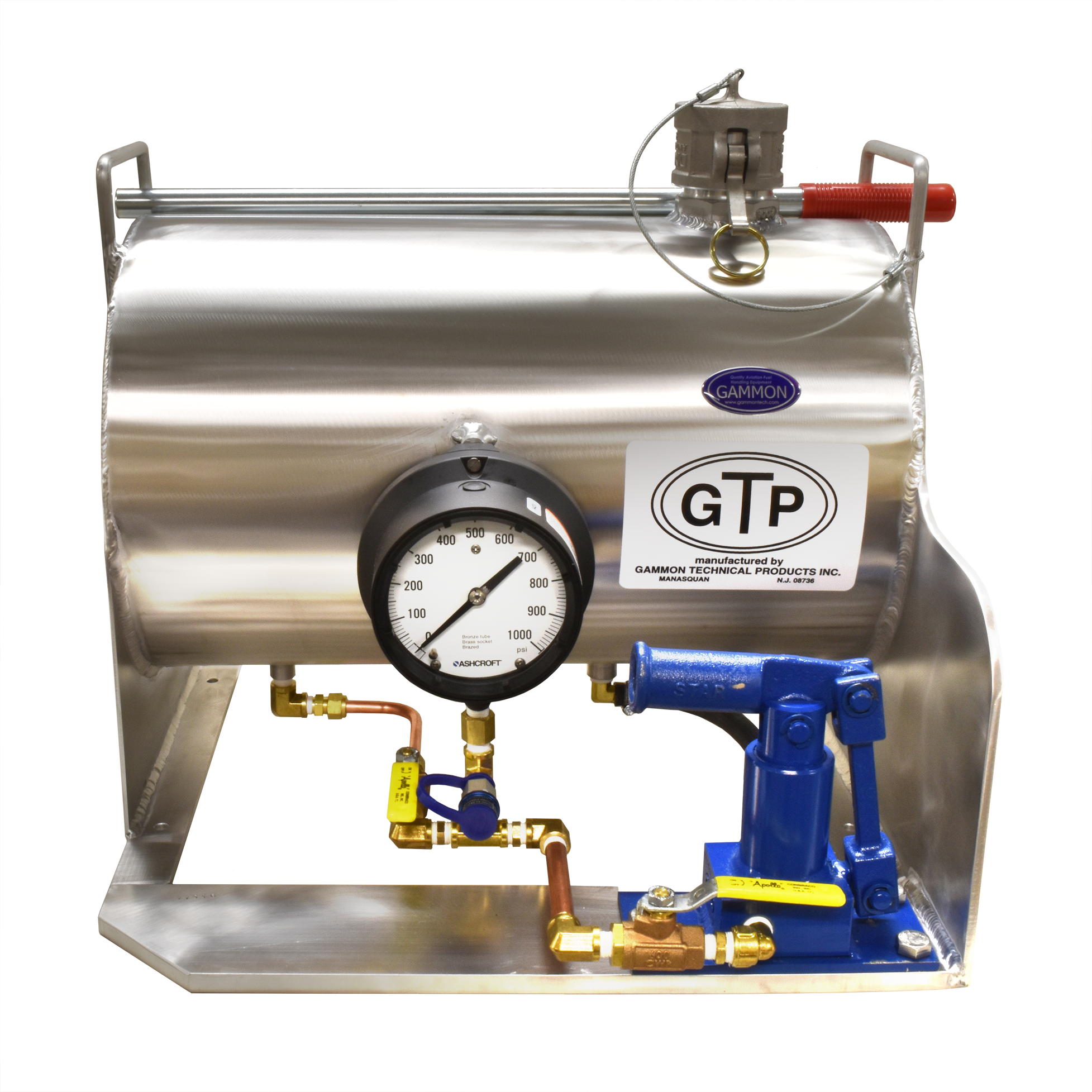
GTP-2157-A
The Gammon Aircraft Refueling Hose Tester is made of non-ferrous materials, designed for periodic testing of jet refueling hose, using jet fuel for pressurizing.
The unit consists of a 10 U.S. gallon (38 liter) aluminum tank (GTP-2234) equipped with a vented fill cap, hand pump (GTP-8076), 0-1000 psi 4.5” face pressure gauge (GTP-281-H), quick disconnect (GTP-1004-4MA), and six feet of 1/4” hose (GTP-8079) to connect to the tester.
Hose Test Procedure

Overview
This tester is designed to perform integrity tests on hose assemblies used in the refueling of aircraft. A thorough inspection of the hose should be done before testing, and if any significant flaw is found, the test should not be run. The purpose of this test is to ensure that the couplings are still secure and that no physical flaw exists that cannot be seen on a physical inspection. AIR MUST NOT BE PRESENT in the system or else, in the event of a failure of the hose or a fitting, the trapped air will cause an explosive release carrying particles at high speed as it expands.
Procedure
The primary application of this tester is for testing aircraft refueling hose in accordance with API Bulletin 1529. When testing newly coupled Grade 1 hose, the test pressure is 300 psi. Periodic tests are required at the working pressure which is 150 psi. When testing Grade 2 hose, the test pressure is 600 psi for newly coupled or recoupled hose, and 300 psi for periodic testing. Because most aircraft refueling hose is Grade 2, the instructions below are written for a 300 psi periodic test with the hose full of jet fuel and remaining attached to the hose reel or to piping on the refueling vehicle.
When testing equipment other than hose, the standard practice is to perform hydrotests at 1.5 times the design or working pressure.
Note: If failure occurs during this test, fuel may be released. Be sure to have the site of the test in a secure area so that the spill will be contained and no fire hazard exists. Wear the proper personal protection such as eye protection.
- Extend the hose to its full length.
- Be sure that:
- No air is present in the hose
- The hose and couplings are fully inspected for flaws
- The hose reel is rated for 300 psi proof pressure and there is a 300 psi rated isolation valve upstream
- The overwing nozzle has been removed and a pipe cap with vent valve has been installed
- The underwing nozzle can handle 300 psi (some brands cannot), and that it is connected to a fueling adapter with a 300 psi rated stop valve downstream. Open the nozzle valve before pressurizing the hose.
- Any hose reel and/or nozzle that does not meet the 300 psi rating has been removed before testing. Install a pipe cap with a vent valve on the hose end.
- The hose is marked all the way around at the edge of the ferrule/fitting with a light coat of paint or by any other means so that you will be able to clearly see if the hose begins to slip out of the ferrule when the hose is pressurized.
Vent valves are used to released all air before pressurizing the hose.
- Close the hose reel inlet valve.
- Connect the supplied hose “A” to the quick disconnect “B” on the hose tester and then to the nozzle, or any other point. Underwing nozzles have a plug in the side which can be used for this purpose. Once again, be sure no air is present in the hose, nozzle, or associated pipe.
- Open valve “C” and step lightly on hose “A” to displace any air in it. Close valve “C.”
- Pump the pressure up to 300 psi in accordance with API-1529 Appendix D for Grade 2 hose, observing for leaks, bubbles, cuts, or blisters. Roll the hose to observe the entire surface. If defects that penetrate the cover material to the reinforcing cord are observed, stop the test; it is a failure. Depressurize immediately as instructed in Step 8 below.
- Look at the paint mark on the hose at the ferrule. If there is more than 1/32″ (0.8mm) gap after the test pressure has been released, the test is a failure; depressurize after the test.
- When the test has been completed, open valve “C” to bleed off pressure by returning the pumped fuel to the hose tested reservoir. Disconnect the test equipment.

